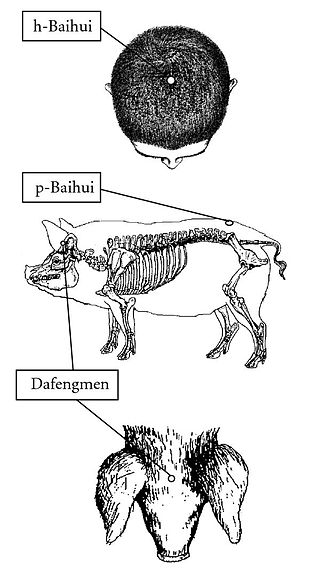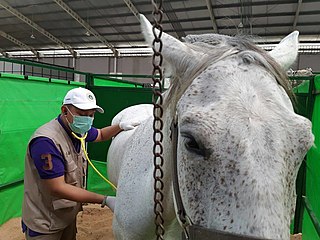
Veterinary medicine is the branch of medicine that deals with the prevention, management, diagnosis, and treatment of disease, disorder, and injury in non-human animals. The scope of veterinary medicine is wide, covering all animal species, both domesticated and wild, with a wide range of conditions that can affect different species.

A veterinarian (vet) is a medical professional who practices veterinary medicine. They manage a wide range of health conditions and injuries in non-human animals. Along with this, veterinarians also play a role in animal reproduction, health management, conservation, husbandry and breeding and preventive medicine like nutrition, vaccination and parasitic control as well as biosecurity and zoonotic disease surveillance and prevention.

An avian veterinarian is a veterinarian who specializes in treating birds. All veterinarians, upon first qualification from a certified veterinary college, may treat any species. Additional training is required for qualification to become a recognized specialist in the care of birds.

The American Veterinary Medical Association (AVMA), founded in 1863, is a not-for-profit association representing more than 99,500 veterinarians in the US.
The University of California, Davis, School of Veterinary Medicine is the largest veterinary school in the United States. Established in 1948, the school is the primary health resource for California's various animal populations. In 2020, the school was again ranked No. 1 in the United States by U.S. News & World Report and in 2022, ranked No. 2 in the world by QS World University Rankings. The school is located in the southwest corner of the main campus of the University of California, Davis. The current Dean of Veterinary Medicine is Dr. Mark Stetter.
The Virginia–Maryland College of Veterinary Medicine is a state-supported college of two states, Virginia and Maryland, filling the need for veterinary medicine education in both states. Students from both states are considered "in-state" students for admissions purposes.
A veterinary specialist is a veterinarian who specializes in a clinical field of veterinary medicine.
Zoological medicine refers to the specialty of veterinary medicine that addresses the care of captive zoo animals, free ranging wildlife species, aquatic animals, birds, reptiles and amphibians, and includes non-domestic companion animals. Zoological medicine incorporates principles of ecology, wildlife conservation, and veterinary medicine, and applies them to wild animals in natural and artificial environments. As a specialty of veterinary medicine in the United States, the American Veterinary Medical Association (AVMA) has recognized the College of Zoological Medicine as the governing body of this specialty field since 1983. As such, zoological medicine is equivalent to other subspecialties of veterinary medicine, which are recognized and governed by their particular colleges.

Veterinary education is the tertiary education of veterinarians. To become a veterinarian, one must first complete a degree in veterinary medicine Doctor of Veterinary Medicine.

Veterinary acupuncture is a form of traditional Chinese medicine and a pseudoscientific practice of performing acupuncture on animals. The best studies of the effects of animal acupuncture have produced consistently negative results.
Veterinary anesthesia is anesthesia performed on non-human animals by a veterinarian or a Registered Veterinary Technician. Anesthesia is used for a wider range of circumstances in animals than in people, due to animals' inability to cooperate with certain diagnostic or therapeutic procedures. Veterinary anesthesia includes anesthesia of the major species: dogs, cats, horses, cattle, sheep, goats, and pigs, as well as all other animals requiring veterinary care such as birds, pocket pets, and wildlife.
Dr. Martin R. Dinnes was a veterinarian from Agua Dulce, California, recognized for his accomplishments in veterinary medicine. He died on December 12, 2017.

Veterinary chiropractic, also known as animal chiropractic, is chiropractic for animals – a type of spinal manipulation. Veterinary chiropractors typically treat horses, racing greyhounds, and pets. Veterinary chiropractic is a controversial method due to a lack of evidence as to the efficacy of chiropractic methods. Contrary to traditional medicine, chiropractic therapies are alternative medicine. There is some degree of risk associated with even skilled manipulation in animals as the potential for injury exists with any technique used. The founder of chiropractic, Daniel David Palmer, used the method on animals, partly to challenge claims that the placebo effect was responsible for favorable results in humans. Chiropractic treatment of large animals dates back to the early 1900s. As of 2019, many states in the US provide statutory or regulatory guidelines for the practice of chiropractic and related treatments on animals, generally requiring some form of veterinary involvement.
Veterinary ethics is a system of moral principles that apply values and judgements to the practice of veterinary medicine. As a scholarly discipline, veterinary ethics encompasses its practical application in clinical settings as well as work on its history, philosophy, theology, and sociology. Veterinary ethics combines veterinary professional ethics and the subject of animal ethics. The subject of veterinary ethics can be interpreted as an extension of critical thinking skills necessary to make the decisions in veterinary care in order to support the profession's responsibilities to animal kind and mankind. There are five main topics that construct the physical usage of Veterinary Ethics. The first being history which describes how these ethics came to be, and how they have changed in the modernization of the veterinary industry. The second is the relation veterinary ethics has with human medical ethics, which together share many values. Third, the principles of these ethics which are updated regularly by the AVMA. Fourth are the key topics of veterinary ethics, which describe what these ethics cover. Last, how these ethics are incorporated into everyday practice and also how they affect those employed in the industry.
The American Association of Bovine Practitioners (AABP) is a nonprofit association of veterinarians who specialize in the care and treatment of bovines such as cattle. AABP has 13 districts covering the United States and Canada, but welcomes membership by veterinarians and veterinary students worldwide. It is the only association for bovine veterinarians, and the largest such association in the world.

Veterinary medicine in the United States is the performance of veterinary medicine in the United States, normally performed by licensed professionals, and subject to provisions of statute law which vary by state. Veterinary medicine is normally led by veterinary physicians, termed veterinarians or vets, but also by paraveterinary workers, such as veterinary technicians, and veterinary assistants. This can be augmented by other paraprofessionals with specific specialties, such as animal physiotherapy or dentistry, and species-relevant roles such as farriers.

The history of veterinary medicine in the Philippines discusses the history of veterinary medicine as a profession in the Philippines. Its history in the Philippines began in 1828, while the Philippines was still a colony of Spain, progressing further during the time when the Philippines became a territory of the United States, until the establishment of the Philippines as an independent Republic in the modern-day era.
Kay Mehren is an American-Canadian veterinarian, who is the former senior veterinarian of the Toronto Zoo. She can be seen in the television series Zoo Diaries.

In Indonesia, veterinary medicine has been practiced for hundreds of years. Veterinary services and education were pioneered during the Dutch colonial era. As of 2023, there are 12 universities that offer veterinary education. The professional organization for veterinarians is the Indonesian Veterinary Medical Association (PDHI).










